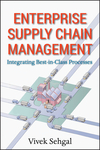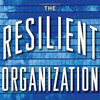 Have you ever played SimCity
Have you ever played SimCity? I never liked Transport Tycoon
that much, but I used to play SimCity a lot, and I still do on occasion, when my wife lets me have my own quality time, and maybe that’s why I fell for this book, because the cover picture looks exactly like a scene from SimCity
. And in some ways the 2009 book Enterprise Supply Chain Management
by Vivek Sehgal really is very “Sim”-like. The book’s focus are the nitty-gritty details of operations and logistics, the flows of ins and outs, while strategic oversight and decisions seem to play a less important role. But only seemingly.
How To
 What we have here is a book that fully covers the complete setup of a supply chain from A to Z
What we have here is a book that fully covers the complete setup of a supply chain from A to Z, with nothing left out, and while strategic considerations are not explicitly mentioned, implicitly they are taken care of. Kudos to Vivek Sehgal for writing this book. In essence, it is an “How to” book on supply chains, covering practically every part of managing a supply chain. It is a book for the supply chain professional, not so much for the company CEO, and less so for a student or researcher like me. It is a hands-on book, it’s practical, and it provides the answers one would need in the daily struggles of managing a supply chain.
The contents

Firstly, the books covers everything there is to know about supply chains, and while it can be read from cover to cover, it is also excellent as a reference, thanks to its extensive and easy to navigate contents
. Secondly, it contains an index that explains all the acronyms used in the book, e.g. COGS, OUTL, CTP, BOR or whatever. Thirdly, there is an appendix on important issues such as ERP, RFID and cross-docking, emerging themes such as green supply chains, commonly used EDI codes and International Commercial Terms. In sum, it is an excellent supply chain handbook, much more than a textbook, which is what I first thought it was.
The book is divided into four parts: Introduction, with a general view of supply chains; Supply Chain Planning, looking at network design and resources allocation; Supply Chain Execution, detailing how to manage supplies, transportation warehousing and reverse logistics; and Supply Chain Collaboration, which I think should have been covered more in detail.
What are supply chains?
What I did like, was the author’s definition of supply chain management as concerned with
the flow and management of resources across the enterprise for the purpose of maintaining the business operations profitably
Note that this extremely generic definition looks at the supply chain as an enterprise-wide undertaking, not only something relegated to the company’s logistics department.
Supply Chain Risk?
As with many books on supply chain management, supply chain risk is not considered. Well, it’s wrong to say this it’s not considered, since the chapter on Supply Management does have a section on strategic sourcing, where the goal is to ensure that
projected business plans and demand can be fulfilled with adequate supplies, optimal costs, and minimal regulatory, financial, social (brand), and legal risks.
The strategic sourcing processes do have some elements of risk assessment in them, and so do many of the other processes that Sehgal describes. It’s an excellent book otherwise, but I wish he had spent some words on risk management, since he obviously is no stranger to supply chain risk and related topics, as this post on his blog confirms.
Conclusion
This is a book written by and for the supply chain industry. Period. It’s an excellent book for the professional, but perhaps not so excellent for the academic. That said, as an academic with little (no) hands-on supply chain experience this is an excellent book for understanding how supply chains work in real life.
Reference
Sehgal, V. (2009). Enterprise Supply Chain Management: Integrating Best-in-Class Processes. Hoboken: Wiley & Sons.
Author link
- linkedin.com: Vivek Sehgal
amazon.com
- Buy this book from amazon.com: Enterprise Supply Chain Management
Related
- husdal.com: Book Review: HBR on Supply Chain Management
- husdal.com: Book Review: Logistics and Supply Chain Management
- husdal.com: Book Review: Logistics Management and Strategy












